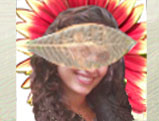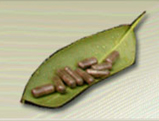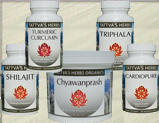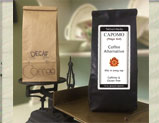 Loading... Please wait...
Loading... Please wait...Providing 25 Years Of Premium Service
Storewide Sale - Save 20%
Blog - sunburns
Role of Seasons in Health & Disease
Posted by Dr. Ch. Murali Manohar, MD Ayurveda – Ayurveda for All on 20th Jul 2010
Ayurveda stresses a lot at the role of seasons on the body and advises that we must change our daily routine depending on the seasons. This is known as ritucharya. It helps in preserving the balance of the doshas as the season changes.
1 . DISORDERS AND DISEASES DUE TO SUMMER
SUNBURNS
They occur easily on the mountains and near the sea as the cliffs and the water reflect sunlight strongly, especially the ultraviolet beam. Dark people are susceptible to sunburn less frequently than the fairer ones. People, used to exposing themselves to the sun, can withstand sunlight better than those who cannot. The signs of sunburn vary from redness to swelling and blistering. The eyelids may swell if the face is affected. There are certain measures that you can take to avoid sunburn and its after-effects.
- Sunburn can be minimized with sun-tanning. This is body’s way of protecting the skin against the burning produced by the sun. The more melanin you produce, the darker you get and the better you are protected against burning.
- Mild sunburn can be treated with cool, wet compresses for 10-15 minutes. Use them three times daily. You might also try soaking in a tub of tepid or cool water for the same period of time.
- In order to get effective protection from the strong rays of sun, the best natural herbal sunscreens are sandalwood and aloe-vera.
- In more serious form of sunburn, your ayurvedic physician may prescribe you medicaments such as Satadhouta ghritam, Aaranaalaadi tailam, Chandanaadi tailam for external application.
PRICKLY HEAT (PIDAKA)
It is an uncomfortable rash that develops in those areas of the body where sweat glands have been temporarily blocked. The common accompanying complaints are burning, tingling and itching. External creams may precipitate or aggravate the condition and heavy sweating may also cause pidaka. Persons with pitta constitution are more prone to this problem. There are some remedial measures that you can take to counteract prickly heat:
- Make a paste by taking equal parts of the powders of sandalwood, coriander seeds, the tubercle of nutgrass (tungamusta) and the roots of khus-khus grass. Mix with rose water and apply on the body to get immediate relief from prickly heat.
- A cold water bath taken after the application of the watery paste of gram flour on the body brings relief.
- The powder of sandalwood used as dust all over the body is very efficacious in bringing relief in prickly heat.
- Chandanabala taila is very good application for prickly heat. It is very effacacious in removing burning and itching sensation of the skin. It is very soothing and tonic to the skin and nerves.
- Intake of Pravaala pishti in dose of 500 mg. twice a day, with honey, helps both in preventing and curing the problem.
- Saaribaadi paanakam, Draakshaadi kashaayam, Shadanga Kashaayam and Jambeeraadi paanakam are famous ayurvedic medicines used internally to combat excessive heat in the body. You can try these medicines on the advice of an ayurvedic physician.
Some people’s hair becomes dry and discolored during the summer months because of over-exposure to the sun. But sun damage, unfortunately, can produce even more serious consequences; in frequent and excessive exposure, it can result in skin cancer.
HEAT CRAMPS
If you expose yourself to prolonged period of excessive heat and humidity, than you may develop heat cramps, which are muscular pains and spasms. Although heat-cramps are the least severe, they are an early signal that your body is having trouble with the heat.
HEAT EXHAUSTION
If you continue to work in humid places where body fluids are lost through heavy sweating, blood flow to the skin increases, causing blood flow to decrease to the vital organs, then this results in heat exhaustion, in which you may feel excessive thirst, profuse sweating, muscle cramps, dizziness, vomiting, fatigue, cold and clammy skin and fainting.
HEAT STROKE
The above condition, if continued, will lead to heatstroke, which can be fatal. Heat-related deaths are especially tragic because they can be prevented. However, excessive heat can impair judgement and cause confusion, so take precautions before you get too hot.
During the heatstroke, the body temperature control system, which produces sweating to cool the body, stops working. (Normally sweating cools the body but if sweat is not allowed to evaporate or if the person has not consumed enough liquids to make up for the loss, the body’s heat production may overwhelm its cooling system). The body temperature can rise so high that brain damage and death may result if the body is not cooled quickly. Symptoms of heat stroke include a fever as high as 105 degrees Fahrenheit with too dry skin, mental confusion, and convulsions. Other signs include rapid pulse and heartbeat, dilated pupils, rapid and shallow breathing, either elevated or lowered blood pressure and unconsciousness.
While waiting for help to arrive, lie down the person in a cool place with elevated legs. Fan the sufferer and, if the person is fully awake, advise him to drink cold water. Loosen tight clothing and removed clothes soaked with perspiration. Apply cool, wet clothes to the skin or ice packs in the armpits, wrists, ankles and groin.
Due to excessive heat, elderly people with chronic heat disease are at high risk of heart attack during summer.
Tips to combat summer heat: There are certain measures that you can take to combat the summer heat and stay cool and comfortable. Follow these guidelines:
- Drink plenty of liquids like coconut water, sugarcane juice, fruit juice, buttermilk or at least 10 glasses of water a day.
- Eat light food – avoid hot, spicy, oily meals and opt for foods high in water content including fruits, salads, soups & buttermilk.
- Lassi made from churned curd, cream & ginger or powder of fried barley dissolved in water acts as a re-hydrating agent in the summer.
- A fresh green mango baked in hot ash or raw mango with salt can quench excessive thirst.
- Avoid alcoholic beverages and drinks containing caffeine (tea and coffee), which can make the condition of heat worse.
- Curd rice prepared by adding boiled rice to curdling milk and kept overnight, should be eaten in morning with plenty of raw onions.
- While going out, wear a white handkerchief or use an umbrella to block sunrays.
- Do outdoor work in the early mornings or late evenings.
- Take frequent baths & showers and apply chandana (sandalwood) paste to body for cooling the body.
- Wear light-colored, loose fitting cotton clothes, preferably muted colors, such as tan.
- Smoking can constrict blood vessels & impair the ability to acclimatise to heat, so quit it.
- Fans blow hot air and increase the amount of evaporation of sweat. So, air conditioners are better.
- Here is a natural soft drink for you. Add 125 grams of khus (roots of Andropogon muricatus) or sandalwood powder of saariba root to one liter of water. Keep it aside for 12 hours. Then churn it and filter. To this filtrate, add three kilos of sugar and boil well to make into syrup. You can drink it as and when needed by diluting with water. This drink can be preserved for 15 days without being spoilt.
- Here is an interesting recipe from Rajasthan – Mix barley flour in buttermilk and boil. Keep it aside overnight and drink the next morning.
- Your lunch should consist of boiled rice or roti with watery decoction of pulses or curries with thin gravy. Always end it with buttermilk or curd. Make it a point to drink some fruit juice in the afternoons after lunch. Similarly, the menu of supper should contain enough onions, mint and coriander leaves, in the form of chutney, made salty and sour by adding salt and lemon juice.
2 . HOW TO COMBAT THE WINTER COLD?
This is the time when a lazy wind starts blowing during the day and the winter responds by showing a reluctance to leave while the summer tries desperately to rush in. An ideal time to fly kites, no doubt, but the body too has to weather the change. Our body is programmed to take care of the changes, but occasionally you may have to aid the process of adjustment through food and suitable alterations in lifestyle!
When a cold, dry wind begins to blow, the vaata (the air in the body system according to Ayurveda) responds, because it is too cold, dry and moving. It senses that something akin to itself has begun to dominate the scene. “Like speaks to like” Vaata starts accumulating.
Traditionally, Ayurveda advises everyone to follow a seasonal routine to preserve balance as the seasons change. This routine does not involve major alterations in your lifestyle, only a shift of emphasis.
During winter, agni (digestive fire) becomes stonger and it can effectively digest heavy and large quantities of food. If you do not eat the right food, agni may even absorb the dhaatus (tissues). To arrest this, take plenty of food. Consume milk, ghee, fat, oils and new rice as dietary staples. Include sour, sweet, and salted soup or meat of awuatic and marshy animals in the diet if you are not a vegetarian.
Try wine, vinegar and honey in the diet. Regularly massage the body with oil. Apply oil on the head. Use room heaters or spend time in heated chambers. Expose the body to the sun’s rays. Avoid light and cold foods. Also, avoid bitter, pungent an astringent tastes. To prevent drying up of the skin, take 100ml milk, add 5 drops olive oil and 8 drops of rose water to it. Apply on the skin gently and smoothly. Then expose yourself to the mild sun for 10 minutes before a warm bath. To keep the face glowing, wash it at least two times a day with lukewarm water. Make a paste of pure flour of bengal gram by adding raw milk. Apply on the face, neck, etc., both in the morning and evening. Alternatively, you can apply the expressed juice of cucumber with 5 drops of mustard oil and rose water in it.
Massaging the skin with mustard oil is good for the skin during winter. Sunrays will enhance the good effects of this procedure. Eat plenty of greens and seasonal fruits. They contain the micro and macro elements, which are required for the smooth functioning of the body.
Soybeans and other pulses are good for cracked lips. Take two teaspoonsfuls of castr oil. Add a pinch of Tankana bhasma (borax) to it. Apply it on the cracked lips.
Cream of milk is also good for cracked lips, if used as an application. Honey is a good and valuable natural healer. Apply it over cracked lips after diluting it with double the quantity of water.















